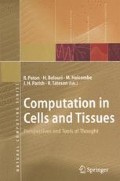Abstract
Ciliate is a term applied to any member of a group of around 10,000 different types of single-celled organisms that are characterised by two unique features: the possession of hair-like cilia for movement, and the presence of two nuclei instead of the usual one. One nucleus (the micronucleus) is used for sexual exchange of DNA, and the other (the macronucleus) is responsible for cell growth and proliferation. Crucially, the micronucleus contains an “encoded” description of the working macronucleus, which is decoded during development. This encoding “scrambles” functional gene elements by both the permutation of coding sequences and the inclusion of non-coding sequences. A picture of the ciliate Oxytricha nova is shown in Fig. 1. During development, ciliates reorganise the material in the micronucleus by removing non-coding sequences and placing coding sequences in the correct order. This ‘unscrambling’ may be interpreted as a computational process during which up to 95% of the original sequence is discarded. The exact mechanism by which genes are unscrambled is not yet fully understood. We first describe experimental observations that have at least suggested possible mechanisms. We then describe two different models of the process. We conclude with a discussion of the computational and biological implications of this work.
Access this chapter
Tax calculation will be finalised at checkout
Purchases are for personal use only
Preview
Unable to display preview. Download preview PDF.
References
D. M. Prescott. Invention and mystery in hypotrich DNA. Journal of Eukaryotic Mi crobiology,45(6): 575–581, 1998.
D.M. Prescott and A.F. Greslin. Scrambled actin I gene in the micronucleus of oxytricha nova. Developmental Genetics,13: 66–74, 1992.
L.F. Landweber and L. Kari. The evolution of cellular computing: Nature’s solution to problem a computational problem. BioSystems, 52 (1–3): 3–13, 1999.
Winfree and David K. Gifford, editors, Proceedings 5th DIMACS Workshop on DNA Based Computers, held at the Massachusetts Institute of Technology, Cambridge, MA, USA June 14–June 15, 1999, pages 207–216. American Mathematical Society, 1999.
A. Ehrenfeucht, I. Petre, D. M. Precott, and G. Rozenberg. Universal and simple op- erations for gene assembly in ciliates. In C. Martin-Vide and V. Mitrana, editors, Where Mathematics, Computer Science, Linguistics and Biology Meet, pages 329–342. Kluwer Academic Publishers, 2001.
A. Ehrenfeucht, I. Petre, D.M. Prescott, and G. Rozenberg. Formal systems for gene assembly in ciliates. Theoretical Computer Science, 2002.
D. M. Prescott and G. Rozenberg. Encrypted genes and their assembly in ciliates. In Martyn Amos, editor, Cellular Computing. Oxford University Press, New York.
Author information
Authors and Affiliations
Editor information
Editors and Affiliations
Rights and permissions
Copyright information
© 2004 Springer-Verlag Berlin Heidelberg
About this chapter
Cite this chapter
Sant, P., Amos, M. (2004). Models of Recombination in Ciliates. In: Paton, R., Bolouri, H., Holcombe, M., Parish, J.H., Tateson, R. (eds) Computation in Cells and Tissues. Natural Computing Series. Springer, Berlin, Heidelberg. https://doi.org/10.1007/978-3-662-06369-9_14
Download citation
DOI: https://doi.org/10.1007/978-3-662-06369-9_14
Publisher Name: Springer, Berlin, Heidelberg
Print ISBN: 978-3-642-05569-0
Online ISBN: 978-3-662-06369-9
eBook Packages: Springer Book Archive

